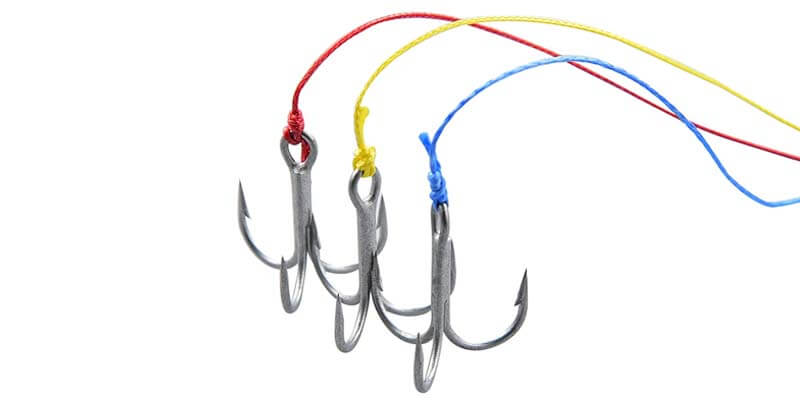The biggest disappointment ever in choosing the best fishing spot, waiting patiently for hours, and when finally that big fish is tugging at your fishing line and you try to reel it in, it breaks. Just like that, the biggest catch of your life slips away. It happened to the best and it takes the best monofilament fishing line to prevent it from ever happening again.
Investing in the best quality monofilament fishing line can save you from that supreme disappointment. If you’re rather new to fishing, you should know that top monofilament fishing lines are made from a single fiber of plastic, have a high amount of sensitivity, while also being quite tough, so they wouldn’t break at the slightest tug.
There are so many choices on the market right now, that choosing the strongest monofilament fishing line, with the proper diameter, sink rate, memory, and abrasion resistance can be difficult. However, I have covered all the essentials related to the best monofilament fishing lines on the market and chosen the best 10 products to put on your shortlist. Moreover, I’ll present you with the buying guide on why and what to pick exactly.
Comparison of 10 Best Monofilament Fishing Lines in 2022
| IMAGE | NAME | FEATURES | PRICE |
|---|---|---|---|
 |
Berkley Trilene Monofilament Spool |
|
Check Price |
 |
Stren Monofilament Fishing Line |
|
Check Price |
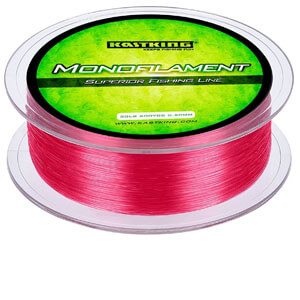 |
KastKing World’s Premium Fishing Line |
|
Check Price |
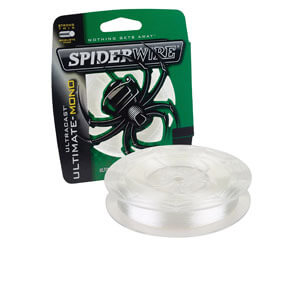 |
SpiderWire Ultracast Monofilament Line |
|
Check Price |
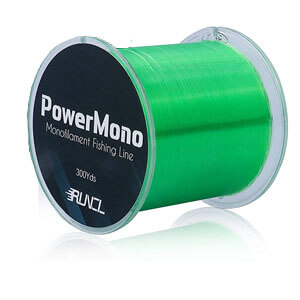 |
RUNCL PowerMono Fishing Line |
|
Check Price |
 |
SeaKnight Monofilament Line |
|
Check Price |
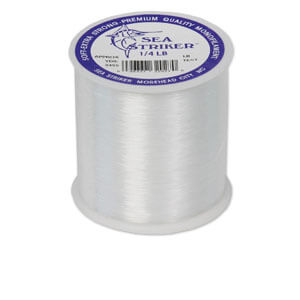 |
Sea Striker Monofilament Line |
|
Check Price |
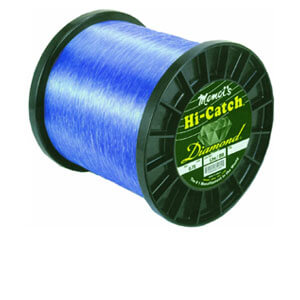 |
Momoi Diamond Monofilament Line |
|
Check Price |
 |
RIKIMARU Premium Fishing Line |
|
Check Price |
 |
Ande Monster Monofilament Line |
|
Check Price |
Top 10 Best Monofilament Fishing Line Reviews in 2022
There are many monofilament fishing line reviews out there and I know it is quite difficult to make a buying decision. Rushing to purchase one random monofilament fishing line because you don’t have time to compare all the different types and features on the market can result in a bad decision or a top-notch choice, but it would all be based on sheer luck.
And do you want to base your next big catch on pure luck? Fishing is a sport and sports are not just about luck. So, let us cover all the different monofilament fishing line types, compare their features, price, and help you make the right choice with an in-depth buying guide. Let’s start!
1. Berkley Trilene Big Game Monofilament Spool
If you’re looking for the best-rated monofilament fishing line out there, then this Berkley Trilene Big Game might just be it. It looks quite “twistable” due to its increased smoothness.
However, it does not compromise on sturdiness and control. It also seems thin and stretchy enough to absorb a good part of the shock of catching a combative fish.
By the look of it, this best monofilament fishing line can serve you well if you plan on going after the big fish, like salmon, or steelhead. It can be used both in fresh or saltwater. Now, to get to the specifics.
Strengths:
- High sensitivity levels
- Good at absorbing shocks
- It looks pretty strong like it could withstand very tough conditions
Weaknesses:
- It has lots of line memory and will need replacement quite often
Also Read: Best Ice Fishing Lines – Picks the Top One
2. Stren High Impact Monofilament Fishing Line
One other viable “candidate” for the best fishing monofilament line is this Stren High Impact Monofilament line. Made from nylon, it scores extra points in the shock resistance department.
It also checks for durability in tough fighting situations against hard-hitting saltwater fish. You can choose from different strengths, sizes, and color variations, depending on your requirements and favorite fishing techniques.
Strengths:
- Good shock resistance on high impacts
- High tensile strength
- Low visibility underwater
Weaknesses:
- It might get tangled up rather quickly and give you a real headache from time to time
3. KastKing World’s Premium Monofilament Fishing Line
Continuing our quest to finding the best quality monofilament fishing line with this product from KastKing. They say it is memory free, strong, and also thin. It looks pretty strong, and like you might not have troubles with it digging too deep into the reel.
It features a memory-free technology called Paralleled Roll Track Technology which makes it easy to handle. It’s made from quality material that does not absorb too much water, to make your fishing experience more enjoyable.
You know, when a line gets imbibed with a lot of water, it can prove to be a real nuisance trying to retrieve it. All in all, this is what we liked and we didn’t like about this product.
Strengths:
- Very little line memory, so no annoying curling or knotting when you least need it
- It looks like it will provide a pretty good casting control
Weaknesses:
- It might be too visible in the water
4. SpiderWire Ultracast Ultimate Monofilament Line
Long, thin, and sensitive, this SpiderWire product may very well qualify as the best monofilament fishing line on the market right now. It is also strong, without sacrificing stretch, and available in a wide range of pound test choices. You should choose yours based on the type of fishing you’re doing.
Strengths:
- It looks abrasion-resistant and quite sturdy
- Can stretch a lot and can pull out big catches
Weaknesses:
- It might not have the best memory and you might struggle with tangles then and now
Also Read: How to Tie Two Fishing Lines Together – You Can Follow the Easy Tips
5. RUNCL PowerMono Monofilament Fishing Line
If you’re looking for a really strong fishing line that could withstand sudden strikes, aggressive hits, show impressive strength and abrasion resistance, then this Runcl product might be the strongest monofilament fishing line that you could choose right now.
This PowerMono fishing line could slowly sink in the water and then float, so if you enjoy fishing topwater, then this might be the best fishing line for you, Moreover, it’s got a little bit of stretch, not much, but enough to absorb violent shocks and prevent them from transferring to your knots and causing breakage.
It seems it provides for easy-to-tie knots, and its large diameter makes it fit for larger fish. It is available in many low and high visibility colors to make it easy or hard to be seen underwater, depending on the different conditions you will encounter. All in all, here’s how we’ll sum it up.
Strengths:
- Strong and durable with a solid knot
- Really impressive low memory for a strong fishing line
- Really abrasion resistant and can hold knots very well
Weaknesses:
- Might be too tight on the spool and prove very difficult to unwind for the first time and the packaging is not the best
6. SeaKnight Monofilament Fishing Line
Made from strong nylon, with increased abrasion and high resistance to possible obstacles in the water, this product from SeaKnight might very well be the best floating monofilament fishing line out there right now.
It provides a good strength- durability balance and its thin diameter provides for good long casting. Looks quite resistant to “rocky” fishing territories, like debris or reefs. It can be used in both fresh and saltwater.
Strengths:
- Great sensitivity
- Good knot strength and an overall good line durability
Weaknesses:
- High line memory
7. Sea Striker Monofilament Fishing Line
Looking for the best monofilament fishing line reviews is not easy. However, this product might just be it. It is highly abrasive, without losing softness and flexibility. It looks like it could be used for heavy trolling without any problem. It’s very strong and won’t break easily.
Moreover, it can also be used for setting up strong traps to protect your garden and much more. Unfortunately, its strength gives it also a strong memory and you might have a hard time with it curling up and knotting.
Strengths:
- Very strong fishing line; won’t break easily
- Good for heavy trolling
Weaknesses:
- Strong memory
Also Read: Baitcaster VS Spinning Reel – Have Best One for Your Needs
8. Momoi Diamond Monofilament Line
This product might just be the highest rated monofilament line out there. It is strong enough for the largest species of fish and features a good deal of stretch. Tough, durable, and with a smooth reeling, this monofilament line looks like a good fit for offshore saltwater fisher. All in all, this is what we liked and what we didn’t:
Strengths:
- Good flexibility makes it is easy to knot
- Proper breaking strength
Weaknesses:
- It’s not a budget fishing line
9. RIKIMARU Premium Monofilament Fishing Line
What impressed me most about this monofilament fishing line is the astonishingly low visibility. For something that looks shiny at first glance, it just about disappears into the water. The catch is you have to pick a color that matches the water of your favorite fishing spot.
Aside from that, another feature that amazed me about this fishing line is the exceptional knot strength. Knot strength in a lot of highly-priced lines often ends up disappointing me. It’s smooth and supple, which is great for knotting, but at the same time quite strong.
Moreover, this line also provides controlled stretch, which, while not as good as zero-stretch, is still adequate in a monofilament line of this price range. It’s quite slippery, and if you’re looking for a monofilament line for fishing in cold water, I can’t imagine anything better than this.
Strengths:
- Very low visibility
- Controlled stretch
- Excellent fishing hook setting capability
- Great castability
Weaknesses:
- The red line isn’t suitable if you’re looking for low visibility
10. Ande Monster Monofilament Fishing Line
Another one on our list of the monofilament fishing line is this Ande Monster Monofilament fishing line. It excels at flexibility and strength, while also keeping the memory to the bare minimum. It is made for tough fishing conditions when that extra strength is needed.
Large mean fish won’t probably stand a chance against this strong fishing line. The knot strength looks on point and it’s got a pretty good resistance to abrasion. It is colored blue to blend in really blue waters.
Strengths:
- Good strength
- Good resistance to abrasion
- Low memory
Weaknesses:
- You might find it hard to cast with it than with other fishing lines
Also Read: Best Fishing Gloves – You Can Use for Protection
How to Decide on the Best Monofilament Fishing Line for You
As I have pointed out above, there are several features to look for when purchasing a monofilament fishing line. I will present them below based on the different fishing types. While some fishing line qualities may be good for some, they might be terrible for others. For example, you can’t fish in deep waters with a high-stretch fishing line because it won’t hook well and won’t be sensitive enough.
However, for topwater, you need a high stretch line, and so on. In other words, the best monofilament fishing line is not fixed, it depends on your style of fishing and what you want to get out of it. There are several qualities to consider when shopping for the top monofilament fishing lines. From its thickness to color, strength, durability, memory, or stretch. Let’s see!
The Fishing Line Color and Thickness
The most popular colors are blue, pink, or hi-vis yellow, but clear might be the best. You could also find a green fishing line, but it’s not that common. Each has its upsides and downsides, they’re not just for fun. For example, the hi-vis yellow fishing line is recommended for fishing at night. It offers better visibility in dark waters or when you’re fishing together, it helps reduce crossing the lines too often.
The clear type of fishing line is the most versatile, the “all-seasoner” here. However, it needs a proper rinse after every usage, because otherwise, it can just turn white from the buildup in the water. Blue is the second most popular color when it comes to fishing lines. It is good for offshore fishing. A pink line is a low-visibility option for white sound beach fishing, while green is also used as a versatile color that could work in many fishing conditions.
The line color should always be chosen based on the environment you’re going to be fishing in. All in all, you want it to be as invisible as possible for the fish, but also have good control over it yourself. It’s fine there. As far as thickness is concerned, you should first think about what kind of fish you’re going to catch.
If you’re going to go for the bigger type of fish, then you should choose a tick line that is strong enough for the job and could withstand a good fight without snapping. Thin fishing lines are good for smaller fish. So if you know you’re fishing for this type of fish, in the right environment, then go for a thin fishing line.
Fishing Line Strength and Durability
For strength, the conditions are pretty much the same as for the thickness. The bigger the fish, the stronger the fishing line should be. If you do not pay attention to this condition, then you might blame it on the line that it snapped. However, most of the time, it’s the fisher’s fault for not choosing the right type of gear for the right fishing type. I know, I’ve been there.
So, for Crappie or flatfish, the strength of the fishing line should not be a priority. These fish are not fighters, so they won’t put up a tough fight against you. However, if you want to catch bigger fish than that, then you will need a fishing line with a considerably high tensile strength to avoid snapping disappointments.
Apart from strength, you should also check the durability quality of the fishing line. It’s not good if it can help you win a tough fight and then cannot be used again. Usually, the durability is given by the overall quality of the material and you choose that based on the brand promise. There are a couple of brands, like the ones highlighted above which promise very good durability over time.
Do not think that durability is not important for you, because you don’t want the line o break when you’re about to pull out that big, saltwater fish. Moreover, you should know that harsh saltwater damage the fishing lines more than freshwater.
Line Memory
Usually, as far as fishing lines are concerned, line memory is bad. It means it holds the previous form and the first time you take it out of the packaging, it will be curled up and difficult to use. Moreover, it tends to tangle on the reels and rods, and instead of sinking, float on top of the water, right? So, when shopping for a fishing line, you need to take a look at reviews and take a good look at the product and mind that memory.
The monofilament fishing line has low memory and stays straight for extended periods. However, there could also be some downsides to fishing lines with very low memory. Over time, they could loosen out. Nevertheless, it’s better to make sure it doesn’t curl up the moment you get it out of its package, so low memory it is. Moving right away to line stretch.
Line Stretch
This is the fishing line’s ability to stretch when a fair amount of pressure is put onto it. If the line has a high stretch capability, it will extend with the pulling force, but not snap. However, there is a fine line when it comes to line stretch. Too much line stretch means too little sensitivity. The less sensitivity a fishing line has, the more difficult it would be to tell if you have caught something or not.
So, there’s no clear guideline here. You should choose the line stretch based on your fishing style. For example, if you like to cast from a boat and let it sink deep while holding it steady waiting for a bite, then you won’t need a high-stretch line, but rather a very sensitive one so you’ll know when you’ve gotten a bite.
Nevertheless, if your favorite style is spinning with lures and top water baits, then you need a more “forgiving” line to help with the possible extra shock from the fish’s fast strike. Line stretch is often referred to as line forgiveness and vice versa, in case you weren’t used with one of the terms. On the products’ description, you will almost always find the term “stretch”.
Why Choose a Monofilament Fishing Line
There are usually three options for fishing lines out there. There is the braided fishing line, the fluorocarbon fishing line, and the monofilament fishing line we’ve been talking about. Braided fishing line is the oldest type of fishing line, still very popular with many anglers today because it doesn’t have any stretch, it’s very thin and can cut through the water with great “panache”.
However, it is quite visible and, although it is very sensitive, we know that the lack of stretch is not always the best option. The fluorocarbon fishing line is usually denser than water, so it sinks easily. It offers proverbial low visibility in the water and it is very resistant to abrasion. However, it is usually twice as expensive as a monofilament line and does not perform well on spinning reels. It’s got a very large diameter.
Best Monofilament fishing lines are somewhere in between these two. Their top quality is that they’re quite versatile. Based on their color, monofilament fishing lines have decreased visibility underwater. So fish are less likely to see them and be put off by them. They are made from a single transparent strand, unlike the braided fishing lines which have a couple of strands braided together in one singular line.
One thing monofilament fishing lines excel at, hats-off, is their capability of being tied up in really strong knots. Last, but not least, monofilament fishing lines might be the best fishing lines for spinning. If you get a hard bite out of nowhere, the line will stretch and absorb the shock and also give you time to react and make that big catch.
The Pros and Cons of Monofilament Fishing Lines
To be more concise, here are the overall pros and cons of monofilament lines and why you should choose one of the 10 products listed above.
- Flexible and easier to handle than other fishing lines
- Shock absorbent; fewer chances of snapping
- Durable in time and rough conditions
- Especially good for spinning with topwater lures
- It absorbs water which softens it in time
- Its high stretch might not make it perfect for heavy-duty fishing styles
- It will weaken over time when exposed to UV light
Buy Only as Much Monofilament Fishing Line as You Need
You shouldn’t just go and buy three or four of the ten products listed ahead just because you couldn’t decide on one and thought it would be better to have more in time. The best monofilament fishing line has a pretty limited shelf life. So try to buy as much line as you think you’ll use in the next 2-3 years and not more.
If you forget it in your basement in its package for more than 3 years, it will accumulate a terrible memory and other reeling and casting problems. If you fish frequently, try to change it 2-3 times per year to make sure that it doesn’t stretch too much and denies you your biggest catch yet.
All in all, you should know that a monofilament fishing line is made from polymers material, like nylon or different mixtures of nylon that can provide the various levels of strength, stretch, memory, and abrasion we have been discussing throughout this article.
Also Read: Best Fishing Pliers – Top 10 Reviews!
Frequently Asked Questions (FAQs)
Q: Which Fishing Line Is Better: Mono or Braid?
A: Both of the fishing lines have their own advantages, and therefore it isn’t easy to choose from them. For instance, the braid does not lose its strength despite the distance, and it does not absorb water. Whereas mono also has excellent strength, but it does get a little fuzzy, and the color fades. Furthermore, fish tends to bite mono better rather than braid. The reason is that the braid is more visible and moves differently through the water.
Q: What Is the Right Amount of Fishing Line You Should Use?
A: The strength of the fishing line is measured in pounds and is known as a test. The main rule for choosing the right amount of fishing line depends upon the species you are fishing. For instance, if you are fishing 20 pounds’ fish, then your line must be around a 20-pound test. But make sure that you are choosing a strong fishing line because you do not want your line to break.
Q: Can You Use a Heavy Fishing Line?
A: Our advice would be not to use a heavy fishing line because by using a heavy line, you develop a risk of tearing your rod. So, ensure that you are using a light fishing line but not too light that it will break.
Conclusion
No monofilament fishing line on this planet can make you a great fisherman. You need dedication, passion, patience, and a lot of experience to master this sport. However, if you’ve taken this much care to choose the best monofilament fishing line on the market, then you’re surely on the right track.


